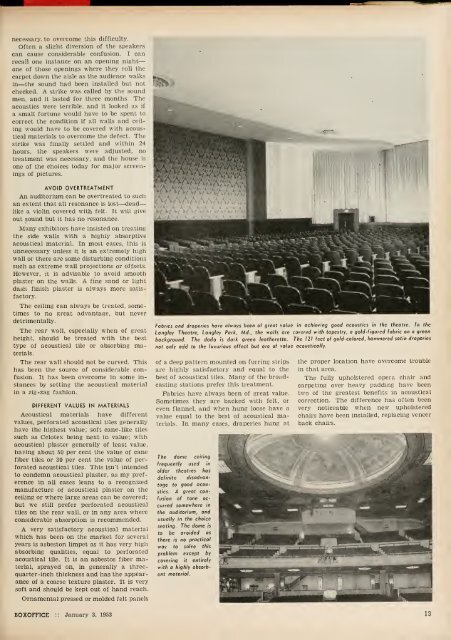Create successful ePaper yourself
Turn your PDF publications into a flip-book with our unique Google optimized e-Paper software.
—<br />
necessary to overcome this difficulty.<br />
Often a slight diversion of the speakers<br />
can cause considerable confusion. I can<br />
recall one instance on an opening night<br />
one of those openings where they roll the<br />
carpet down the aisle as the audience walks<br />
in—the sound had been installed but not<br />
checked. A strike was called by the sound<br />
men, and it lasted for three months. The<br />
acoustics were terrible, and it looked as if<br />
a small fortune would have to be spent to<br />
correct the condition if all walls and ceiling<br />
would have to be covered with acoustical<br />
materials to overcome the defect. The<br />
strike was finally settled and within 24<br />
hours, the speakers were adjusted, no<br />
treatment was necessary, and the house is<br />
one of the choices today for major screenings<br />
of pictures.<br />
AVOID OVERTREATMENT<br />
An auditorium can be overtreated to such<br />
an extent that all resonance is lost—dead<br />
like a violin covered with felt. It will givr<br />
out sound but it has no resonance.<br />
Many exhibitors have insisted on treating<br />
the side walls with a highly absorptive<br />
acoustical material. In most cases, this is<br />
unnecessary unless it is an extremely high<br />
wall or there are some disturbing conditions<br />
such as extreme wall projections or offsets.<br />
However, it is advisable to avoid smooth<br />
plaster on the walls. A fine sand or light<br />
dash finish plaster is always more satisfactory.<br />
The ceiling can always be treated, sometimes<br />
to no great advantage, but never<br />
detrimentally.<br />
The rear wall, especially when of great<br />
height, should be treated with the best<br />
type of acoustical tile or absorbing materials.<br />
The rear wall should not be curved. This<br />
has been the source of considerable confusion.<br />
It has been overcome in some instances<br />
by setting the acoustical material<br />
in a zig-zag fashion.<br />
DIFFERENT VALUES IN<br />
MATERIALS<br />
Acoustical materials have different<br />
values, perforated acoustical tiles generally<br />
have the highest value; soft cane-like tiles<br />
such as Celotex being next in value: with<br />
acoustical plaster generally of least value,<br />
having about 50 per cent the value of cane<br />
fiber tiles or 30 per cent the value of perforated<br />
acoustical tiles. This isn't intended<br />
to condemn acoustical plaster, as my preference<br />
in all cases leans to a recognized<br />
manufacture of acoustical plaster on the<br />
ceiling or where large areas can be covered;<br />
but we still prefer perforated acoustical<br />
tiles on the rear wall, or in any area where<br />
considerable absorption is recommended.<br />
A very satisfactory acoustical material<br />
which has been on the market for several<br />
years is asbeston limpet as it has very high<br />
absorbing qualities, equal to perforated<br />
acoustical tile. It is an asbestos fiber material,<br />
sprayed on, in generally a threequarter-inch<br />
thickness and has the appearance<br />
of a coarse texture plaster. It is very<br />
soft and should be kept out of hand reach.<br />
Ornamental pressed or molded felt panels<br />
Fabrics and draperies have always beert of great value in achieving good acoustics in the theatre. In the<br />
Langley Theatre, Langley Park, Md., the walls are covered with tapestry, a gold-figured fabric on a green<br />
background. The dado is dark green leatherette. The 121 feet of gold-colored, hammered satin draperies<br />
not only add to the luxurious effect but are of value acoustically.<br />
of a deep pattern mounted on furring strips<br />
are highly satisfactory and equal to the<br />
best of acoustical tiles. Many of the broadcasting<br />
stations prefer this treatment.<br />
Fabrics have always been of great value.<br />
Sometimes they are backed with felt, or<br />
even flannel, and when hung loose have a<br />
value equal to the best of acoustical materials.<br />
In many cases, draperies hung at<br />
The dome ceiling<br />
frequently used in<br />
older theatres has<br />
definite<br />
disadvantage<br />
to good acoustics.<br />
A great confusion<br />
of tone occurred<br />
somewhere in<br />
the auditorium, and<br />
usually in the choice<br />
seating. The dome is<br />
to be avoided as<br />
there is no practical<br />
way to solve this<br />
problem except by<br />
covering it entirely<br />
with a highly absorbent<br />
material.<br />
the proper location have overcome trouble<br />
in that area.<br />
The fully upholstered opera chair and<br />
carpeting over heavy padding have been<br />
two of the greatest benefits in acoustical<br />
correction. The difference has often been<br />
very noticeable when new upholstered<br />
chairs have been installed, replacing veneer<br />
back chairs.<br />
BOXOFFICE January 3, 1953 13

















